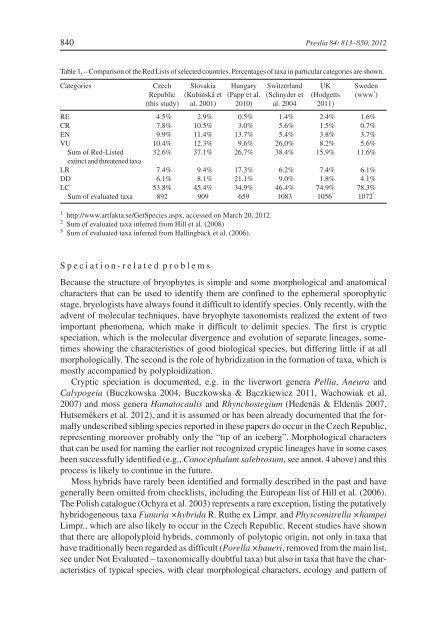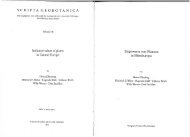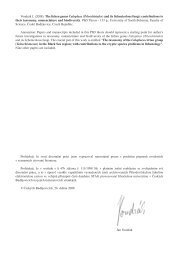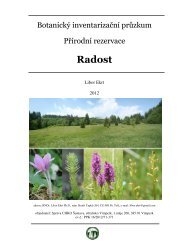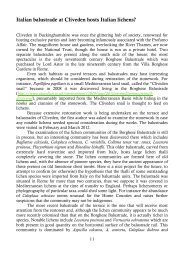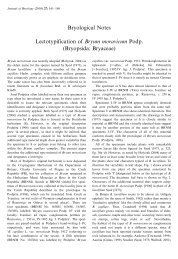Bryophyte flora of the Czech Republic: updated checklist and Red ...
Bryophyte flora of the Czech Republic: updated checklist and Red ...
Bryophyte flora of the Czech Republic: updated checklist and Red ...
Create successful ePaper yourself
Turn your PDF publications into a flip-book with our unique Google optimized e-Paper software.
840 Preslia 84: 813–850, 2012<br />
Table 1. – Comparison <strong>of</strong> <strong>the</strong> <strong>Red</strong> Lists <strong>of</strong> selected countries. Percentages <strong>of</strong> taxa in particular categories are shown.<br />
Categories <strong>Czech</strong><br />
<strong>Republic</strong><br />
(this study)<br />
Slovakia<br />
(Kubinská et<br />
al. 2001)<br />
Hungary<br />
(Papp et al.<br />
2010)<br />
Switzerl<strong>and</strong><br />
(Schnyder et<br />
al. 2004<br />
UK<br />
(Hodgetts<br />
2011)<br />
Sweden<br />
(www 1 )<br />
RE 4.5% 2.9% 0.5% 1.4% 2.4% 1.6%<br />
CR 7.8% 10.5% 3.0% 5.6% 1.5% 0.7%<br />
EN 9.9% 11.4% 13.7% 5.4% 3.8% 3.7%<br />
VU 10.4% 12.3% 9.6% 26.0% 8.2% 5.6%<br />
Sum <strong>of</strong> <strong>Red</strong>-Listed 32.6% 37.1% 26.7% 38.4% 15.9% 11.6%<br />
extinct <strong>and</strong> threatened taxa<br />
LR 7.4% 9.4% 17.3% 6.2% 7.4% 6.1%<br />
DD 6.1% 8.1% 21.1% 9.0% 1.8% 4.1%<br />
LC 53.8% 45.4% 34.9% 46.4% 74.9% 78.3%<br />
Sum <strong>of</strong> evaluated taxa 892 909 659 1083 1056 2<br />
1072 3<br />
1 http://www.artfakta.se/GetSpecies.aspx, accessed on March 20, 2012.<br />
2 Sum <strong>of</strong> evaluated taxa inferred from Hill et al. (2008)<br />
3 Sum <strong>of</strong> evaluated taxa inferred from Hallingbäck et al. (2006).<br />
Speciation-related problems<br />
Because <strong>the</strong> structure <strong>of</strong> bryophytes is simple <strong>and</strong> some morphological <strong>and</strong> anatomical<br />
characters that can be used to identify <strong>the</strong>m are confined to <strong>the</strong> ephemeral sporophytic<br />
stage, bryologists have always found it difficult to identify species. Only recently, with <strong>the</strong><br />
advent <strong>of</strong> molecular techniques, have bryophyte taxonomists realized <strong>the</strong> extent <strong>of</strong> two<br />
important phenomena, which make it difficult to delimit species. The first is cryptic<br />
speciation, which is <strong>the</strong> molecular divergence <strong>and</strong> evolution <strong>of</strong> separate lineages, sometimes<br />
showing <strong>the</strong> characteristics <strong>of</strong> good biological species, but differing little if at all<br />
morphologically. The second is <strong>the</strong> role <strong>of</strong> hybridization in <strong>the</strong> formation <strong>of</strong> taxa, which is<br />
mostly accompanied by polyploidization.<br />
Cryptic speciation is documented, e.g. in <strong>the</strong> liverwort genera Pellia, Aneura <strong>and</strong><br />
Calypogeia (Buczkowska 2004, Buczkowska & Bączkiewicz 2011, Wachowiak et al.<br />
2007) <strong>and</strong> moss genera Hamatocaulis <strong>and</strong> Rhynchostegium (Hedenäs & Eldenäs 2007,<br />
Hutsemékers et al. 2012), <strong>and</strong> it is assumed or has been already documented that <strong>the</strong> formally<br />
undescribed sibling species reported in <strong>the</strong>se papers do occur in <strong>the</strong> <strong>Czech</strong> <strong>Republic</strong>,<br />
representing moreover probably only <strong>the</strong> “tip <strong>of</strong> an iceberg”. Morphological characters<br />
that can be used for naming <strong>the</strong> earlier not recognized cryptic lineages have in some cases<br />
been successfully identified (e.g., Conocephalum salebrosum, see annot. 4 above) <strong>and</strong> this<br />
process is likely to continue in <strong>the</strong> future.<br />
Moss hybrids have rarely been identified <strong>and</strong> formally described in <strong>the</strong> past <strong>and</strong> have<br />
generally been omitted from <strong>checklist</strong>s, including <strong>the</strong> European list <strong>of</strong> Hill et al. (2006).<br />
The Polish catalogue (Ochyra et al. 2003) represents a rare exception, listing <strong>the</strong> putatively<br />
hybridogeneous taxa Funaria ×hybrida R. Ru<strong>the</strong> ex Limpr. <strong>and</strong> Physcomitrella ×hampei<br />
Limpr., which are also likely to occur in <strong>the</strong> <strong>Czech</strong> <strong>Republic</strong>. Recent studies have shown<br />
that <strong>the</strong>re are allopolyploid hybrids, commonly <strong>of</strong> polytopic origin, not only in taxa that<br />
have traditionally been regarded as difficult (Porella ×baueri, removed from <strong>the</strong> main list,<br />
see under Not Evaluated – taxonomically doubtful taxa) but also in taxa that have <strong>the</strong> characteristics<br />
<strong>of</strong> typical species, with clear morphological characters, ecology <strong>and</strong> pattern <strong>of</strong>


